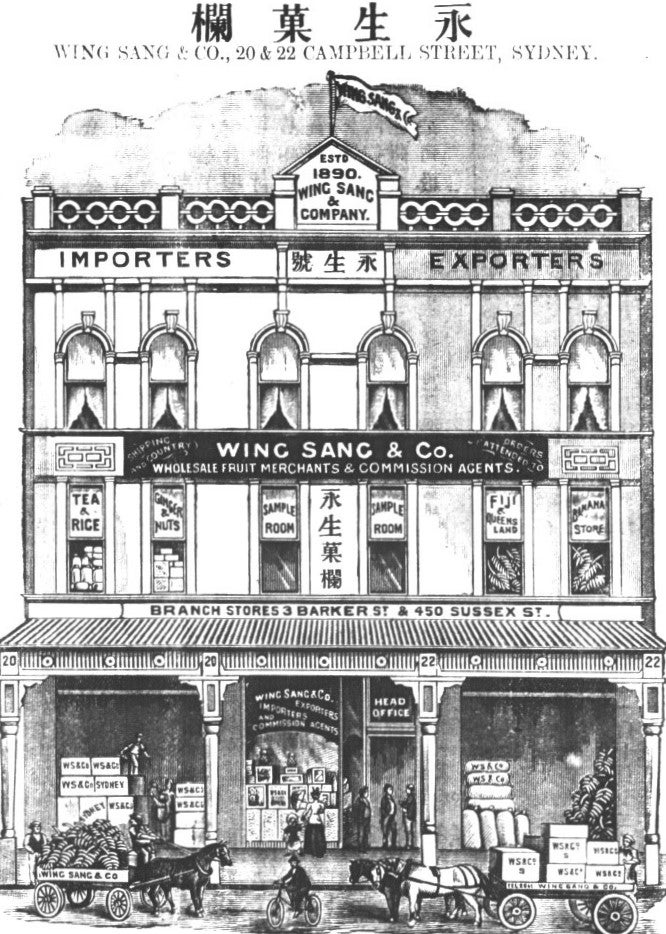
The Wing Sang & Co buildings, Sydney
The founders of Wing Sang (from left Wing Chan Ma, George Bew Kwok, Ying Piu Ma, James Hing Choy). The photo was taken around 1890 (City of Sydney Archives, photo donated by Gordon Mar)
Wing Sang & Co. (meaning ‘Eternity’ in Chinese) was an import and export fruit merchant and commission agent which operated in Haymarket of Sydney between 1890-1984. Wing Sang was founded in 1890, originally as a fruit shop by a group of Chinese who came from Zhongshan County in Guangdong (Kuo, 2013). The company registration certificate (1905) shows it was registered as a ‘fruit merchants and commission agents’ by George Bew Kwok (郭标), Mark Joe (馬永燦), James Hing Choy (蔡興), Tuck Sue (萧德), Ying Piu Ma [written as Mark M Puie] (馬應彪), Sam Ick, Ing Chan and Thomas Chong Choy (蔡昌).
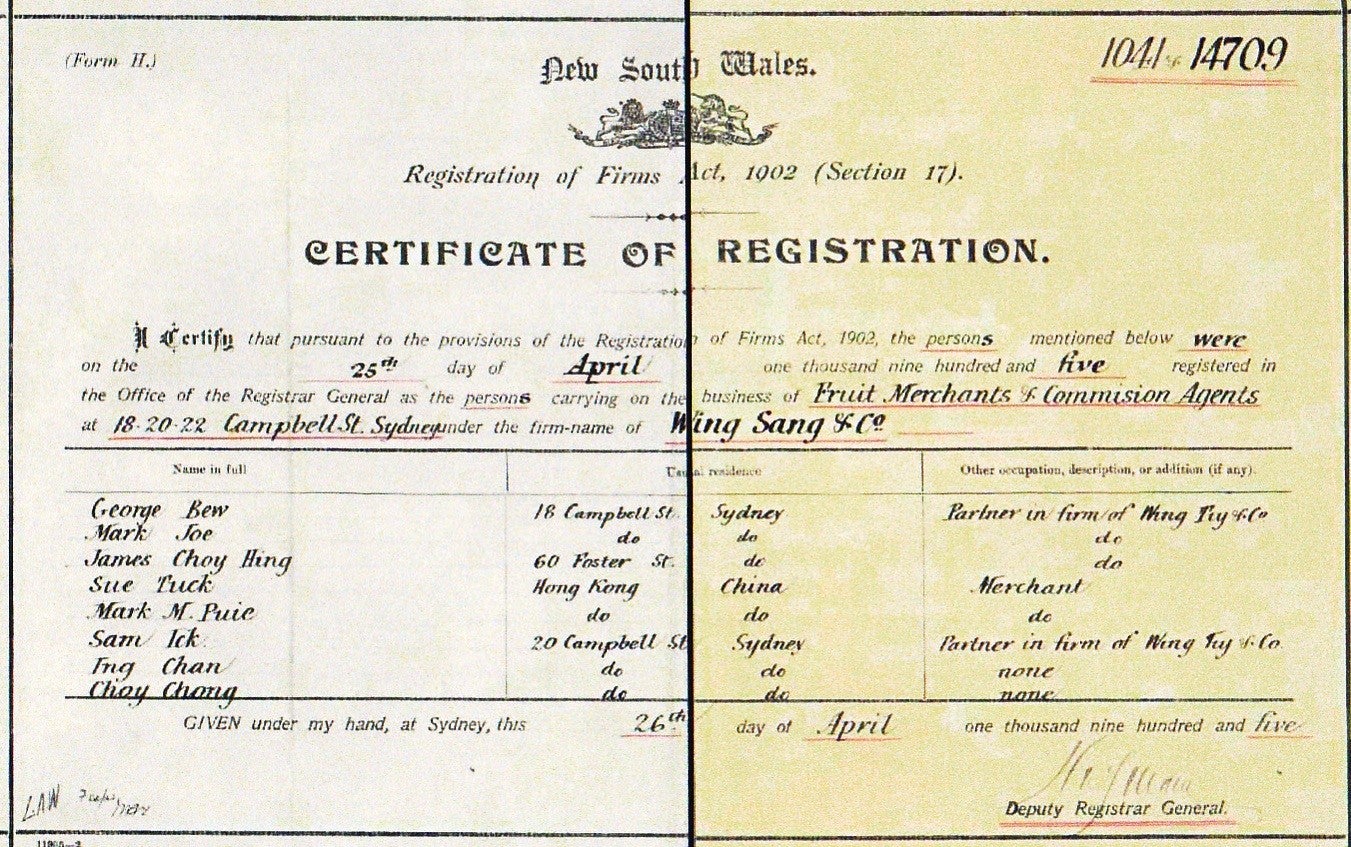
The business registration certificate of Wing Sang & Co in 1905 (courtesy of Howard Wilson)
Wing Sang operated at several locations in Sydney’s Haymarket area at different times. It is difficult establish an exact timeline for these locations due to a lack of detail in the historical records. The information below comes from newspaper sources, the City of Sydney Archives and archival material collected by Howard Wilson.
Buildings associated with Wing Sang
The buildings occupied by Wing Sang were all close to the growers’ markets in the Haymarket. In the late 19th century, Belmore Market was located on the site of the present-day Capitol Theatre. The company’s first premises were opposite Belmore Market, at 26-28 Campbell Street (Evening News, 29 October 1892). In 1892 they moved around the corner to 449 Pitt Street.

Wing Sang’s letterhead in 1901. The company’s head office was on 20-22 Campbell Street, Haymarket at this time, and it had branches on 3 Barker Street (Darling Harbour) and 450 Sussex Street in Sydney (courtesy of Howard Wilson)
Three years later, in 1895, the company returned to Campbell Street, renting the larger part of a three storey commercial building occupying numbers 18-22 (constructed in 1892) from the famous businessman and retailer Samuel Hordern (a director of the Anthony Hordern & Sons Department Store in Sydney). It is believed the building was made available to Wing Sang due to their founders’ association with the Presbyterian Church, Hordern being a member of the Church network (Kuo, 2013). The building on Campbell Street, which still stands, is in the Victorian Federation style. It has panels below the second-floor windows in the style of the Chinese screen, reflecting the interest in ‘Oriental art’ in Australia in the 1890s (NSW Office of Environment and Heritage, 2019). Apart from the Campbell Street offices, Wing Sang also operated a branch on 3 Barker Street in the Darling Harbour Fruit Exchange in 1901.

The 1890s building at 18-22 Campbell Street, Haymarket. Wing Sang occupied this building from 1895
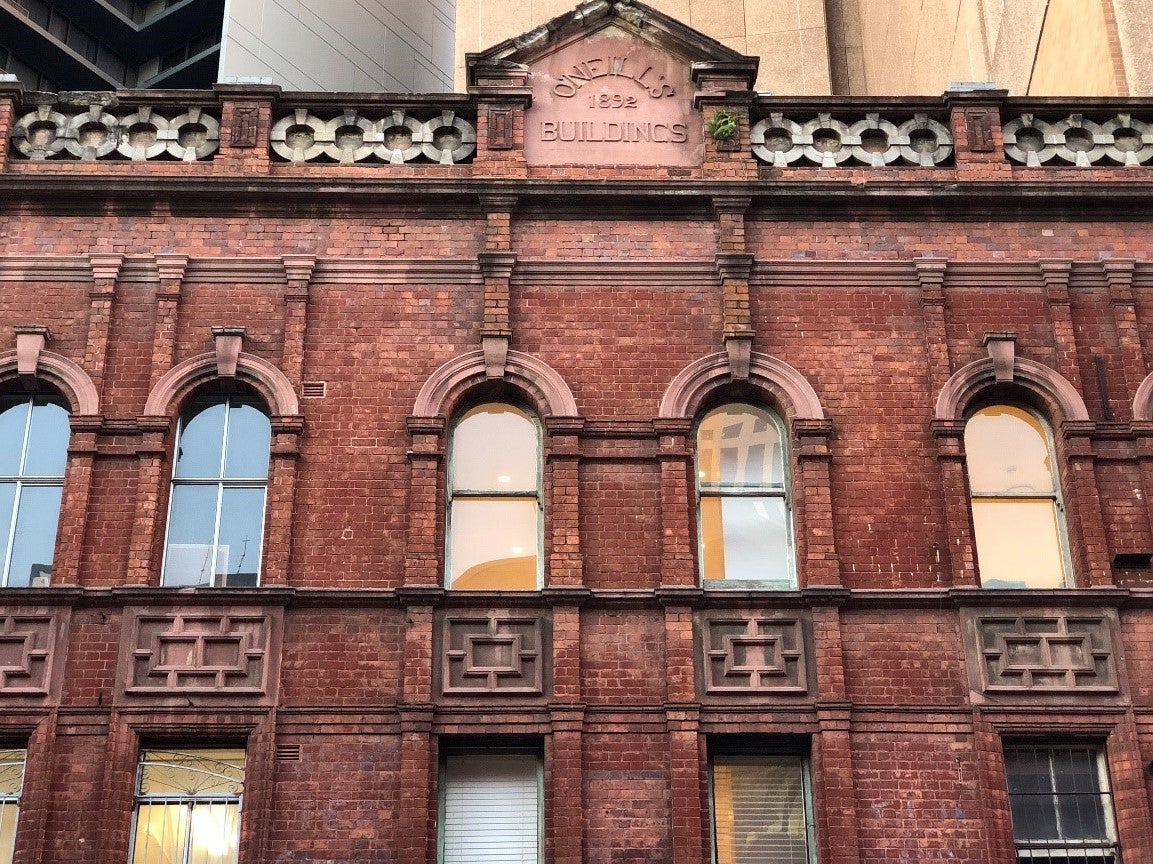
The façade of 18-22 Campbell Street. The panels (or tablets) below the 2nd floor windows are in the style of a Chinese wooden screen, reflecting the interest in Chinese art in Australia in the 1890s
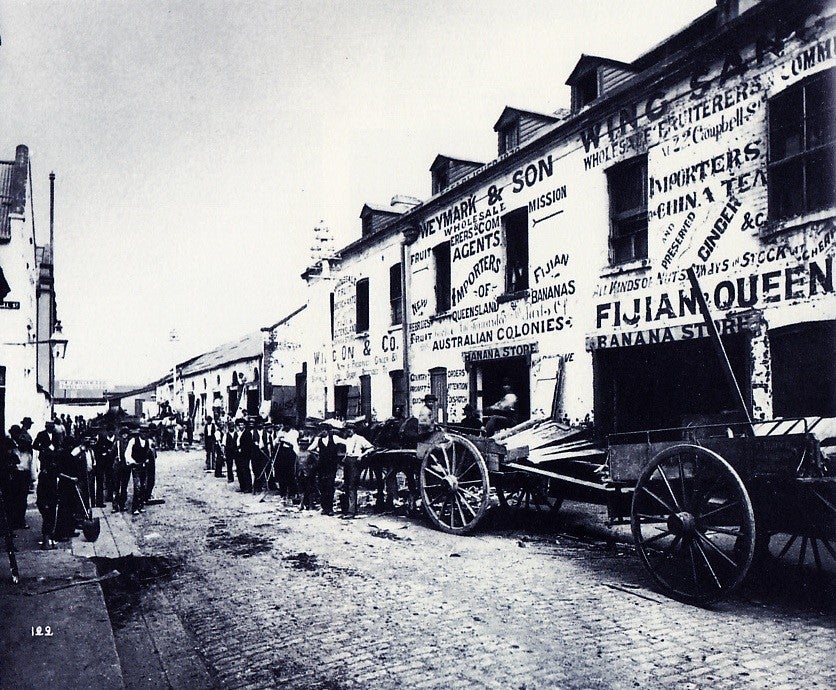
Wing Sang’s branch on Barker Street, Darling Harbour (1900-1902) (State Library of NSW, courtesy of Howard Wilson)
In 1904, the company rented a building on 18 Campbell Street as its office and used the top floor as the accommodation for employees. Wing Sang purchased 18 Campbell Street in 1931 (it had moved out of the adjacent 20-22 Campbell Street in around 1911). According to Gordon Mar, his parents Harry Leong Wah Mar and Sin Ho Lee lived there when they first arrived in Sydney in 1930. The property was later sold by Gordon Mar in around 1972 when the growers’ market began to move to Flemington.
By 1909, the old Belmore Market closed and was replaced by Paddy’s Market, located in a sprawling triangular brick building bounded by Hay, Quay and Thomas Streets. Wing Sang rented a three storey warehouse building from the City of Sydney Council on the corner of Sussex and Hay Street (90 Hay Street) in 1909. It was a three storey brick building with the front carved sandstone window ledges and ornate parapet bearing a shield of crossed cornucopia and dated ‘Est 1890’. Below the shield, the name ‘Wing Sang & Co’ was painted on the façade, and below the windows on the second level was painted ‘Fruit Merchants and Commission Agents’ (City of Sydney photo archives, 1910)
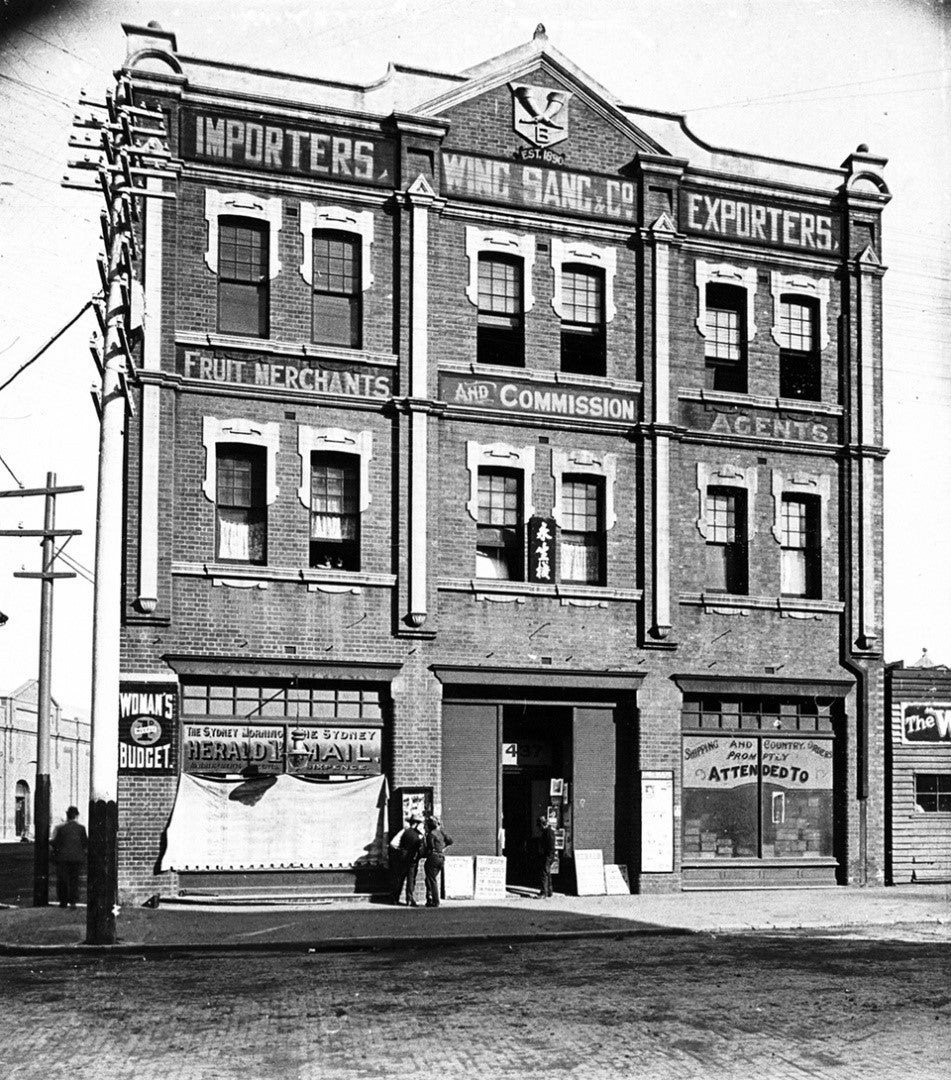
Wing Sang’s building on the corner of Sussex and Hay Streets (City of Sydney Archives, circa. 1910)

Wing Sang’s warehouse building on Sussex and Hay Streets in about 1910 (City of Sydney Archives, circa 1910)
Three years later, in 1912, the company rented another three storey warehouse building from the City Council, at 58 Hay Street (corner of Quay, Hay and Lackey Streets) as its head office. The warehouse building was leased for an initial term of 15 years (18 June, 1913, Sydney Morning Herald). The Wing Sang office was downstairs while the top floors were turned into bedrooms for employees. Wing Sang occupied this building until 1975 when it relocated to the new growers market at Flemington, a suburb in the Inner West of Sydney. The building on the site of 58 Hay Street was demolished in around 1980 for the construction of the Sydney Entertainment Centre. In 1984, Wing Sang Co. was sold to a group of Italian buyers. According to Gordon Mar, the younger generation of the Mar family having no interest in continuing the fruit wholesale business.
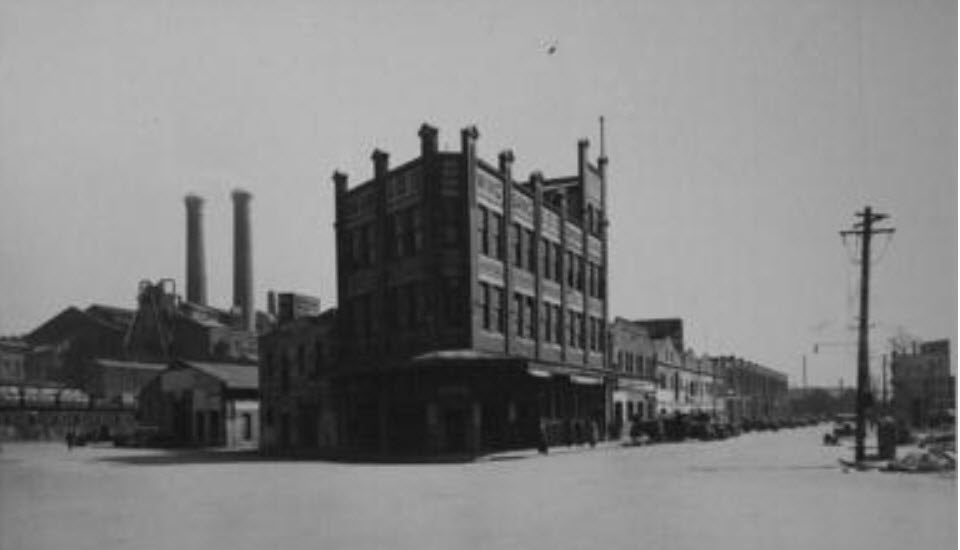
Wing Sang’s head office on the corners of Quay, Hay and Lackey Streets (City of Sydney Archives, 1937)
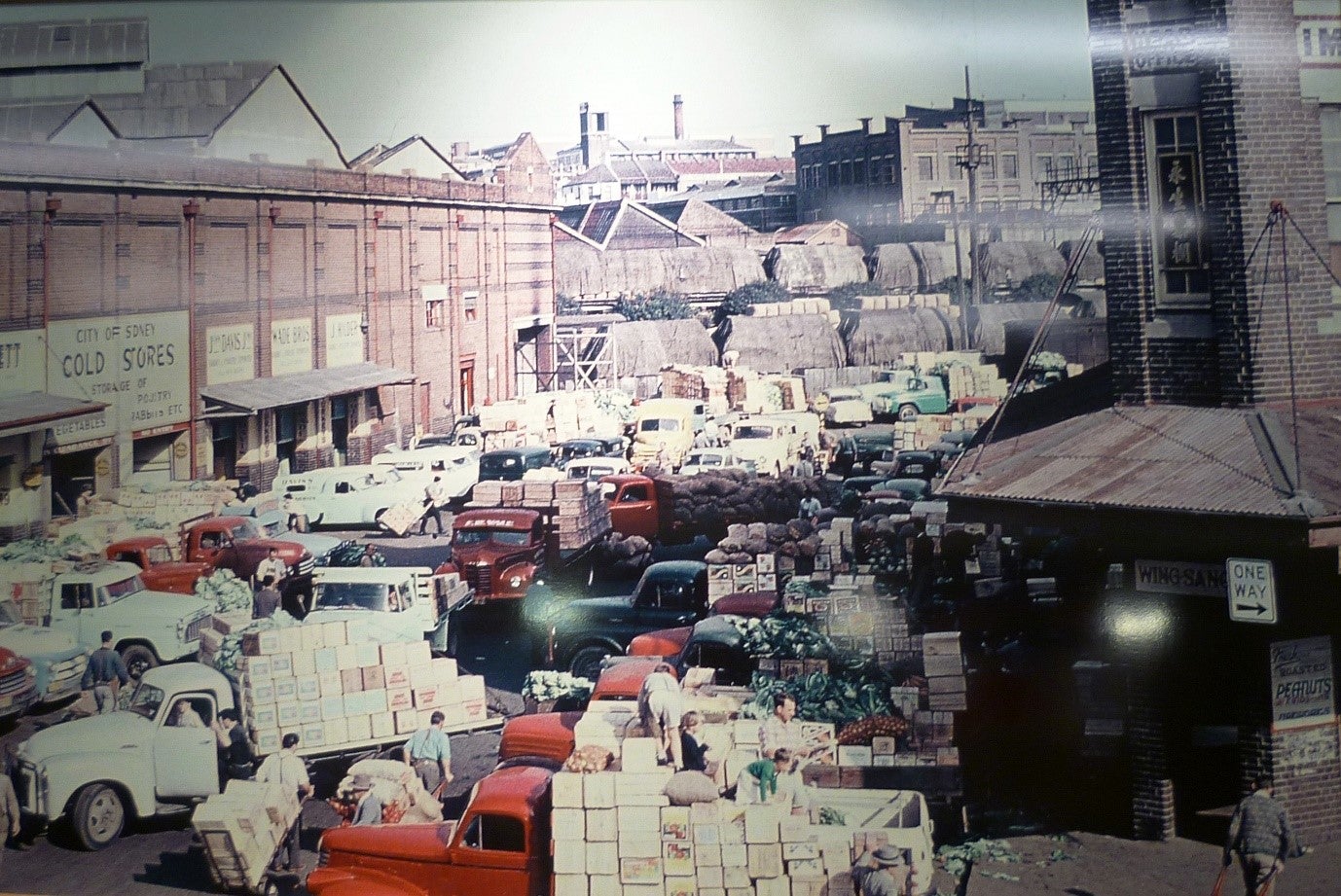
Wing Sang’s head office on 58 Hay Street, opposite of Paddy’s Market (City of Sydney Archives, courtesy of Howard Wilson)
Being the top fruit merchant in Sydney for much of the 20th century, Wing Sang could bring in family members and employees from China under the White Australia Policy restrictions. The company sponsored people from Zhongshan, especially those from the Mar clan of Shachong village, to work for them in Sydney. Many employees lived on the top floors of the company head office on 58 Hay Street. According to Gordon Mar, two mezzanine levels were added to the three-storey building. A chef was employed to cook meals for the employees.
A timeline for Wing Sang’s business locations in Sydney’s Haymarket:
| 1890 | Wing Sang begins operating at 26-28 Campbell Street |
| 1892 | moved to 449 Pitt Street |
| 1895 Nov | opened new branch at 22 Campbell Street |
| 1900 | extended by renting 20 Campbell Street |
| 1901 | operated at 20-22 Campbell Street, 3 Barker Street, and 450 Sussex Street |
| 1904 | operated at 18-22 Campbell Street, 450 Sussex Street, 14 Barker Street |
| 1906 | operated at 18-22 Campbell Street, Steam Mill Street Fruit Exchange |
| 1908 | operated at 18-22 Campbell Street |
| 1909 | opened new premises on the corner of Sussex and Hay Streets (90 Hay Street), rented from the Sydney Council, a branch on 18 Campbell Street |
| 1912 | head office moved to Hay and Lackey Streets (58 Hay Street), branches at 90 Hay Street, 18 Campbell Street and Steam Mill Street |
| 1927 | head office on 58 Hay Street, branches on 12 Steam Mill Street, 90 Hay Street, 18 Campbell Street |
| 1931 | bought 18 Campbell Street |
| 1935 | head office on 58 Hay Street, premises at 18 Campbell Street |
| 1972 | sold the building on 18 Campbell Street |
| 1975 | moved from 58 Hay Street to Flemington |
Wing Sang and the banana trade
Wing Sang was one of the top three banana merchants in Sydney. Originally, the coimpany imported bananas from northern Queensland, especially from Chinese growers in Cairns and Townsville. In 1902 a joint venture company ‘Sang On Tiy & Co’ was formed with two other Chinese fruit merchants in Sydney, Wing On & Co (established 1897) and Tiy Sang & Co (established 1893). They acquired a 350 acre piece of land near Suva in Fiji to develop as a banana plantation. Louie Gay (the maternal grandfather of William George Lee) was known to have managed the plantation before he returned to Sydney around 1910.
The bananas imported from Fiji by ‘Sang On Tiy’ were distributed to fruit shops in Sydney and regional NSW. From 1902 the company imported at least 2000 bunches of banana from Fiji per week. Given the wholesale price of a bunch of Fijian banana in the early 1900 was about 3 shilling 6 pences to 6 shillings, it was estaimated that the yearly turnover of Wing Sang from the Fijian trade was between £18,200 and £31,200 between 1901-1913 (Young 1977, p. 50). Sang On Tiy also operated plantations in northern NSW. The Wing Sang letterhead (1912) states that the company imported a wide range of products including China tea, preserved ginger, oils, all kinds of nuts, fireworks and rice.
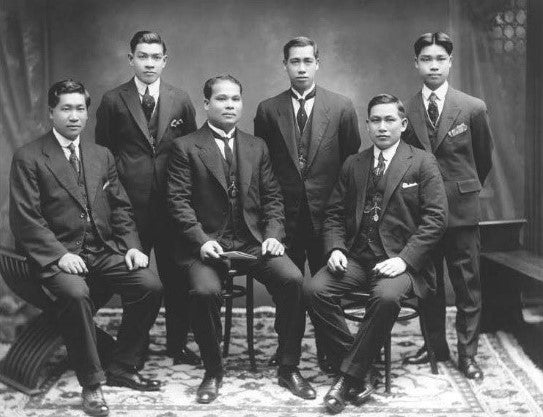
The managers of Wing Sang in 1924. Back row standing from left: Sing You Mah, Sun Gee Mar (Gordon Mar’s grandfather), Leong Wah Mar (Gordon Mar’s father). Front row sitting from left: Chut Mar; Shee Poy Mar (Glenn Mar’s grandfather), Wai Mar. (City of Sydney Archive donated by Gordon Mar)
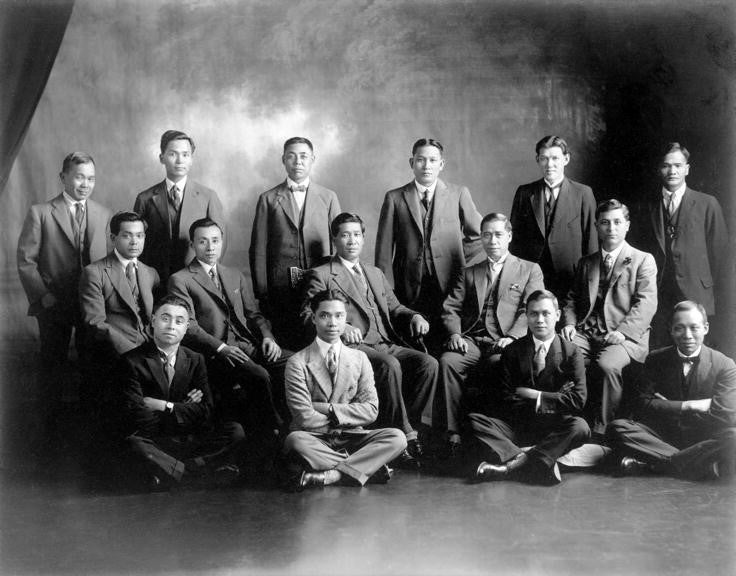
Employees of Wing Sang in around 1930. Gordon Mar’s father Leong Wah Mar is sitting on the floor, second from the left. In the middle row, Chut Mar is sitting in the middle row in the centre, next to him on the right is Sun Gee Mar (Gordon’s grandfather) (City of Sydney Archives donated by Gordon Mar)
Reflecting on the nearly 100 years of operation of Wing Sang, Gordon Mar stressed ‘it served its purpose’ he continued, ‘The purpose of the company was to bring our family to Australia, to find work. And that’s what it did. The actual company, the business, in the Haymarket, basically had their uses, because that’s where the people came from the village and lived there, and worked there’.
References:
Kuo, Mei-Fen (2013) Making Chinese Australia: Urban elites, newspapers and the formation of Chinese-Australian identity, Clayton, Victoria: Monash University Publishing
Young, C. F. (1977) The new gold mountain : The Chinese in Australia, 1901-1921, Richmond, S.A. : Raphael Arts
